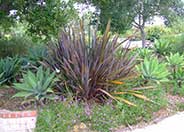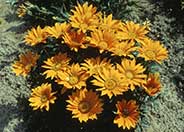
Common name:Daylily (hybrid selection)
Botanical name:Hemerocallis hybrids
These summer-blooming perennials form clumps with large, grass-like leaves. Its showy flowers, resembling lilies, are borne in clusters on stems held well above the foliage. Daylilies can be found in many colors: yellow, orange, red, purple, pink or multi-colored. Hemerocallis does better in well-draining soil and with extra summer water. Hemerocallis are very hardy,with few or none pests/problems.

Common name:New Zealand Flax, Purple
Botanical name:Phormium tenax 'Atropurpureum'
Phormium tenax 'Atropurpureum' is an evergreen perennial. Big, dramatic plant composed of many swordlike, stiffly vertical leaves can reach 5' tall. Leaves are purple red. Flowers stems reach high above leaves, bearing clusters of 1"-2" blossoms in dark red.
Maintenance Tips
Phormium tenax 'Atropurpureum' is one of the most popular hybrids of Flax. This variety matures at 4-6' tall and wide. The leaves are strap-shaped, and deep purple, tall flower stalks appear in the summer up to 10' tall. To keep the maintenance as low as possible, plant in a location that is full sun, and well-drained and give it the space it needs to reach maturity. These plants are often the victim of poor pruning habits, with gardeners cutting the leaves off in the middle or shearing them because they are too large for the space they have been given. If this is the case, they should be transplanted to a location where they can reach their full size, or other plants around them should be moved out of their way. Old leaves rarely fall off of the plant, so removing them as they age will help keep the plant looking and performing its best.
Common name:Lavender Cotton
Botanical name:Santolina chamaecyparissus
This ground cover/small shrub will grow to 2' tall and has small, grayish silver leaves with yellow flowers that bloom in the summer.
Maintenance Tips
Santolina chamaecyparissus is a Mediterranean native that can be found in many California gardens. It is very drought tolerant and is very low maintenance if it is planted in a location where it can reach its full mature size of 2’ tall to 3’ wide. This plant is susceptible to root rot or fungal diseases if the soil is too wet or doesn’t drain easily. If the plant develops fungal issues, allow the soil to dry out and treat with a systemic fungicide. This plant usually blooms in the summer, and the plant will continue to bloom if you deadhead the spent flowers. In the late winter or early spring, you can cut back the foliage by one-third of the current size to maintain the size and encourage new growth.
Common name:Kurrajong
Botanical name:Brachychiton populneus
Bottle Tree Kurrajong (Brachychiton populneus) is a large, evergreen tree native to Australia. It can reach 50’ tall and 30’ wide but has been planted and maintained in residential gardens to stay in the 20-30' height range. It is a very ornamental tree that has interestingly shaped leaves and clusters of white flowers that develop into seed pots that rattle in the wind. If this tree is selected for a small garden, it will require regular pruning and shaping to keep it to a desired size. The seed pots can also create a mess under the tree, so it is best to plant this tree in a location that can absorb the droppings. Once this tree is established, it requires very little water, so it is a great choice for drought-tolerant gardens. When it reaches a more mature size, leave the pruning to a licensed arborist to keep it looking and performing at its best. This tree should be planted at least five feet away from any hardscape areas, 10 feet from structures such as houses and buildings, and not near any powerlines. Shrubs and perennials should be planted about three feet away from this tree. It should be irrigated for about 45 minutes once a week when using most in-line drip irrigation systems.

Common name:Sprenger Asparagus
Botanical name:Asparagus densiflorus 'Sprengeri'
This plant is given a soft, mound-like appearance by the long, arching branches that are found covered with small, bright green leaves. It is able to grow in either full sun or partial shade. This plant is fast growing and can be invasive.
This plant is poisonous if ingested.

Common name:Hybrid Gazanias
Botanical name:Gazania hybrids
These ground covers will grow less than 1' tall and have medium size, gray green leaves with gold, lavender, orange, red, yellow, or white flowers that are present all year.
Designer: California Native Garden
Photographer: GardenSoft